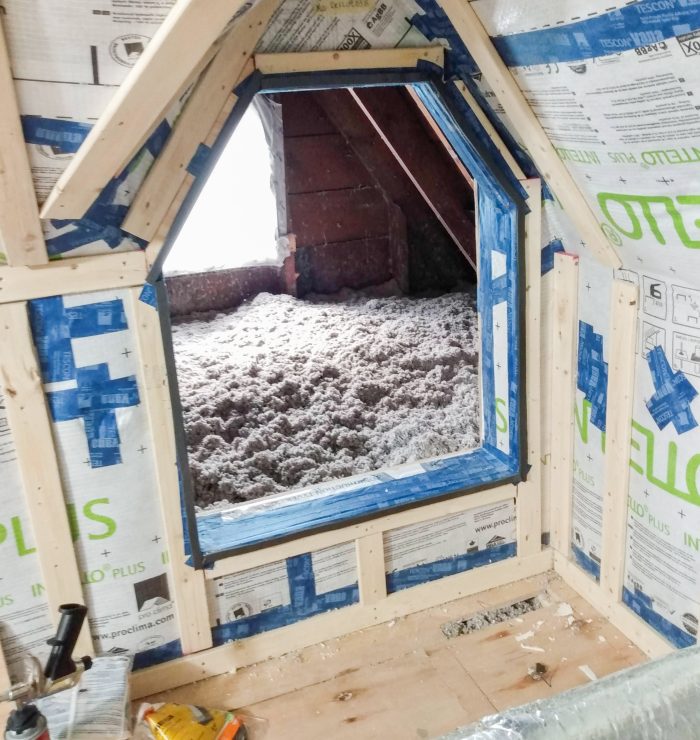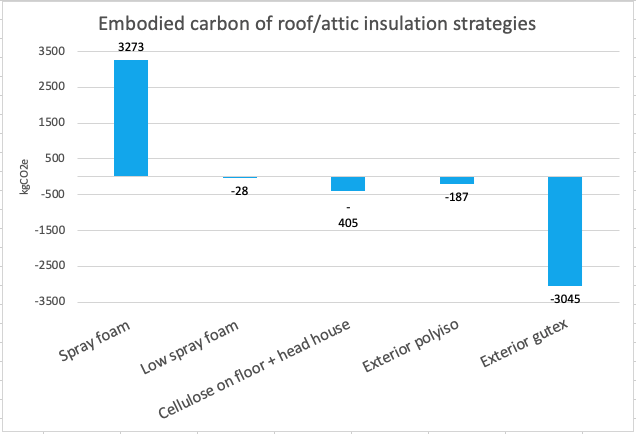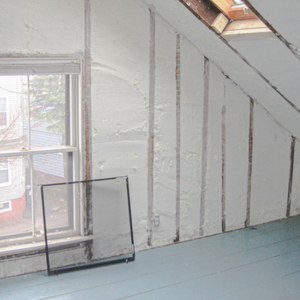
This is the second of three posts on strategies for lowering embodied carbon in renovated attics. The first, “Tackling Embodied Carbon in Retrofits,” can be read here.
A wide-open attic with no storage and no mechanical equipment—can you remember the last time you worked on an attic like this? I sure can’t. Most of the attics Byggmeister retrofits already house an air handler. Or they will soon, as the majority of our projects include at least partial electrification, and attic space is prime real estate for ducted heat pumps. Most attics we work on also serve some storage function.
For a long time, we assumed that the only viable approach to attics like these was to bring them indoors, either by insulating the underside of the roof with spray foam or by adding board insulation on top of the roof sheathing.
But a couple of years ago, as we began to prioritize embodied carbon, we revisited this assumption. Maybe we could bring attics indoors using less foam. Maybe we could bring just enough attic space indoors to house mechanicals and use the remainder for carbon storing cellulose. And so, we developed two new, carbon smarter attic insulation strategies.
The first, which we call the low foam approach, is appropriate when there are significant attic storage needs. We build down the rafters; install 3” or R-20 closed cell foam against the underside of the roof sheathing for condensation control (in climate zone 5; See Table R806.5 of the 2015 IRC for other zones); install a smart membrane; and then dense pack the built-down rafters with cellulose for a total of R-49.

The second, which we call the head house approach, is appropriate when there are minimal attic storage needs. We build a small room or “head house” for the air handler; install the air barrier along the floor and then up and over the head house; install and seal the air handler and ductwork; and then insulate.
(For details on this approach, see the drawings in the Gallery.)
Assuming that we can ascribe carbon storage potential to the cellulose, our calculations indicate that the first strategy would be close to carbon neutral, with the carbon storage potential of cellulose mostly offsetting the emissions from spray foam. Our calculations indicate that the second strategy would be carbon positive, turning the attic into a carbon sink.
There are two reasons why we have focused on interior rather than exterior insulation approaches. First, outsulation is much more expensive and only makes financial sense if the roof is also due for replacement. Outsulation with polyisocyanurate is roughly 3.5 times the cost of spray foam, while outsulation with wood fiber board is roughly 4.5 times the cost. Second, outsulation can have significant adverse architectural impacts.
With the low-foam strategy, the biggest challenge we’ve faced is increased cost: it’s roughly 1.5 times more expensive than all spray foam. With the head house strategy, implementation has been trickier. It has taken some trial and error to get this right in the field.

One reason it’s considered best practice to put the air and thermal boundary at the roof is that it minimizes plane changes. With the head house approach, this boundary needs to transition from horizontal, to vertical, and then back to horizontal again. Each plane changes introduces possible discontinuities in the air barrier. The first time we built a head house, we didn’t fully think through sequencing and ended up spending a lot of time fixing the air barrier.
The head house approach also puts more pressure on duct sealing. While leaky ducts are never a good idea, outside the thermal boundary, they lead to higher energy use and can contribute to condensation and ice damming. With the head house approach, we are finding that we need to spend significantly more time on HVAC quality control.
We’ve also discovered that rebalancing the HVAC system is a pain when the dampers are buried in cellulose. It’s not so much of a pain that we wouldn’t recommend or follow this approach, but it is definitely something to be aware of.
It’s also worth emphasizing that the head house is most practical when storage needs are minimal. While it’s possible to build a larger head house to accommodate more stuff, a larger head house is more expensive. Our first approach with clients who have a lot of stuff is to gently suggest some purging. If that doesn’t work, our default is now the low-foam, build-down approach. If we can’t eliminate carbon-intensive spray foam, at least we can minimize it.
Rachel White is the CEO of Byggmeister, a design-build remodeling firm in Newton, Mass.
Weekly Newsletter
Get building science and energy efficiency advice, plus special offers, in your inbox.














12 Comments
> 3” or R-20 closed cell foam
When it comes to sheathing moisture, use very long term (like 40 year) R values, account for variability and be conservative (vs code minimum). So use 4".
> increased cost
Your approach would be clearer if you normalized to $/ton of CO2e. Looks like it would be smarter to use all spray foam and then spend $50 of the savings on some other, more efficient carbon reducing endeavor.
Thanks Jon. We did look at the cost per ton of carbon saved, which I neglected to include in the post. For our analysis we looked at carbon savings to 2030. We chose 2030 because of the time value of carbon: because we are quickly approaching a climate tipping point emissions avoided in the near term are more important than emissions avoided further down the road. Our analysis indicates that in the year 2030, the all spray foam approach would still be carbon negative. In my opinion that eliminates it as a carbon smart approach, given that the climate clock is ticking and there are viable cost effective alternatives. Indeed, the head house approach costs less than all-spray foam. I've attached image captures of the cost and carbon analyses we did for reference. Note that we based these analyses on hard costs.
$ per kg when the going rate is in tens of $ per TON? Your graphs wildly support my point. Choose the least expensive option (all foam) and spend a little of the savings elsewhere to achieve a better carbon result at a far lower cost.
Thanks for another great article. I was hoping you could tell us what timeline you’re using to calculate the kgCO2e on the graph. How many years is that over?
Hi Brian, In most cases we set our boundary conditions at cradle-to-factory gate. So we looked at emissions in lifecycle stages A1-3 (raw material, transport to factory and manufacturing). For spray foam we also included B1 because of emissions that occur during the use phase. Did that answer your question?
I think there was a blog here a few years ago with a great strategy for super-insulating an attic that has too much stuff stored in it: a machine that directly processes stacks of old paper into cellulose insulation, thus solving two problems in one step. Sadly, that was just a fantasy, not a real machine.
Charlie,
I think they are called mice.
It should be noted that a thermal barrier is needed to protect most types of spray foam unless the attic space is used "only for repairs or maintenance". Otherwise, 1/2" drywall or 3/4" sheathing is needed below the netted and blown cellulose (R316.5.3).
This is similar to approaches I've seen, except that the (expensive) Intello membrane and tapes become unnecessary if the ratio of closed cell foam to cellulose stays within the safe margin defined in the IRC for condensation control (R806.5). It's not doing much in this application that the spray foam isn't already doing better, provided the foam is thick enough.
> thermal barrier ... 1/2" drywall or 3/4" sheathing
Or various other things, such as RockWool Comfortboard.
"Or ... Comfortboard"
Right, at which point the cellulose starts to seem extraneous in spite of the carbon benefit. I anticipate getting some funny looks if I propose three different insulations for one assembly.
Code officials can be sticklers on the thermal barrier. Storage use seems to be the trigger, but who can resist using a fully conditioned attic for that?
Enjoyed this. Any further insight on appropriate sequencing for building the head house? Is it membrane first then seal as each penetration is made? Or ducts first then try to seal membrane around those?
To make sure I understand, is polyiso 3.5 times more expensive than closed cell spray foam because of the need to replace the roof or is that raw materials? I had thought rigid foam was usually cheaper than spray foam, at least if planning a new house. Also, is this article taking into account lower GWP spray foam?
Log in or create an account to post a comment.
Sign up Log in